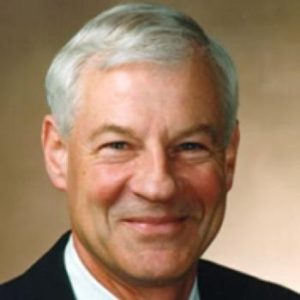Prof. Ronald K. Hanson (Stanford): PW Distinguished Lecture: New Strategies for Laser Diagnostics and Shock Tube Imaging
Speaker: Dr. Ronald K. Hanson, Stanford University
Date: Apr 26, 2019; Time: 2:30pm Location: BPB Rm. 131
 Abstract: This presentation will introduce two new ideas for laser diagnostics applicable to combustion and propulsion and two new ideas for high-speed imaging of combustion phenomena in a shock tube. The first laser diagnostic to be discussed is Spectrally-Resolved Fluorescence, in which a narrow-linewidth wavelength-tunable laser source is rapidly scanned over one or more absorption transitions, allowing collection of a spatially resolved laser-induced fluorescence signal that reflects the strength and shape of the absorption feature. This diagnostic can potentially provide accurate determinations of temperature, pressure, flow velocity and the concentration of the absorbing species. The example to be presented will be of OH excited and detected in the ultraviolet (UV). The second new laser diagnostic utilizes a narrow-linewidth infrared laser source that can be scanned rapidly over a relatively wide wavelength range, thereby enabling acquisition of spectral absorption cross-sections over a full rovibrational absorption band of combustion-relevant species in a short time (a few milliseconds), compatible with the test times available in reflected shock wave experiments. The goal of the experiments is to generate a unique data base for cross-sections over a wide range of temperature, not feasible in a heated static cell. Two other experiments will be presented, both based on imaging of shock-heated gases. In the first experiment, high-speed imaging is used to visualize and characterize aspects of inhomogeneous ignition that can occur in reflected shock wave experiments of hydrocarbon fuel ignition; such inhomogeneous ignition is undesirable and can contaminate data sets aimed at providing high-quality information on ignition delay times. As a second example of imaging in a shock tube, a new experiment will be introduced that measures the burning velocity of a flame produced by laser ignition of combustible gases behind a reflected shock wave. The objective is to enable flame speed measurements at elevated temperatures not accessible with conventional flame speed techniques. Such conventional methods are limited by the partial reaction of the mixture that occur during the lengthy period of preparing reactive mixtures, whereas with a shock tube experiment the time interval between shock wave heating and ignition can be adjusted to be quite small. Results obtained in heptane-air flames provide clear evidence of cool flame effects not previously seen in flame speed experiments. In current work, the observation of flame speed from the time-resolved position of chemiluminescent emission is also being augmented by various laser absorption diagnostics to additionally characterize the burned gases behind the flame.
Abstract: This presentation will introduce two new ideas for laser diagnostics applicable to combustion and propulsion and two new ideas for high-speed imaging of combustion phenomena in a shock tube. The first laser diagnostic to be discussed is Spectrally-Resolved Fluorescence, in which a narrow-linewidth wavelength-tunable laser source is rapidly scanned over one or more absorption transitions, allowing collection of a spatially resolved laser-induced fluorescence signal that reflects the strength and shape of the absorption feature. This diagnostic can potentially provide accurate determinations of temperature, pressure, flow velocity and the concentration of the absorbing species. The example to be presented will be of OH excited and detected in the ultraviolet (UV). The second new laser diagnostic utilizes a narrow-linewidth infrared laser source that can be scanned rapidly over a relatively wide wavelength range, thereby enabling acquisition of spectral absorption cross-sections over a full rovibrational absorption band of combustion-relevant species in a short time (a few milliseconds), compatible with the test times available in reflected shock wave experiments. The goal of the experiments is to generate a unique data base for cross-sections over a wide range of temperature, not feasible in a heated static cell. Two other experiments will be presented, both based on imaging of shock-heated gases. In the first experiment, high-speed imaging is used to visualize and characterize aspects of inhomogeneous ignition that can occur in reflected shock wave experiments of hydrocarbon fuel ignition; such inhomogeneous ignition is undesirable and can contaminate data sets aimed at providing high-quality information on ignition delay times. As a second example of imaging in a shock tube, a new experiment will be introduced that measures the burning velocity of a flame produced by laser ignition of combustible gases behind a reflected shock wave. The objective is to enable flame speed measurements at elevated temperatures not accessible with conventional flame speed techniques. Such conventional methods are limited by the partial reaction of the mixture that occur during the lengthy period of preparing reactive mixtures, whereas with a shock tube experiment the time interval between shock wave heating and ignition can be adjusted to be quite small. Results obtained in heptane-air flames provide clear evidence of cool flame effects not previously seen in flame speed experiments. In current work, the observation of flame speed from the time-resolved position of chemiluminescent emission is also being augmented by various laser absorption diagnostics to additionally characterize the burned gases behind the flame.
Bio Sketch: Professor Hanson received his bachelor’s degree from Oregon State University in mechanical engineering and his doctoral degree from Stanford University where he currently holds the Woodard Chair in Mechanical Engineering. He has been an international leader in the development of laser-based diagnostic methods for combustion and propulsion, and in the development of shock tube methods for accurate determination of chemical reaction rate parameters needed for modeling combustion and propulsion systems, and together with his students he has made several pioneering contributions that have advanced the pace of propulsion research and development worldwide. He is a Fellow of AIAA, ASME and OSA, a member of the National Academy of Engineering, and a recipient of gold medal awards from the Combustion Institute, the Institute for Dynamics of Explosions and Reactive Systems, and multiple gold medals from the AIAA. He has published over one thousand papers and advised over 100 doctoral students, including 31 now holding faculty appointments around the world.